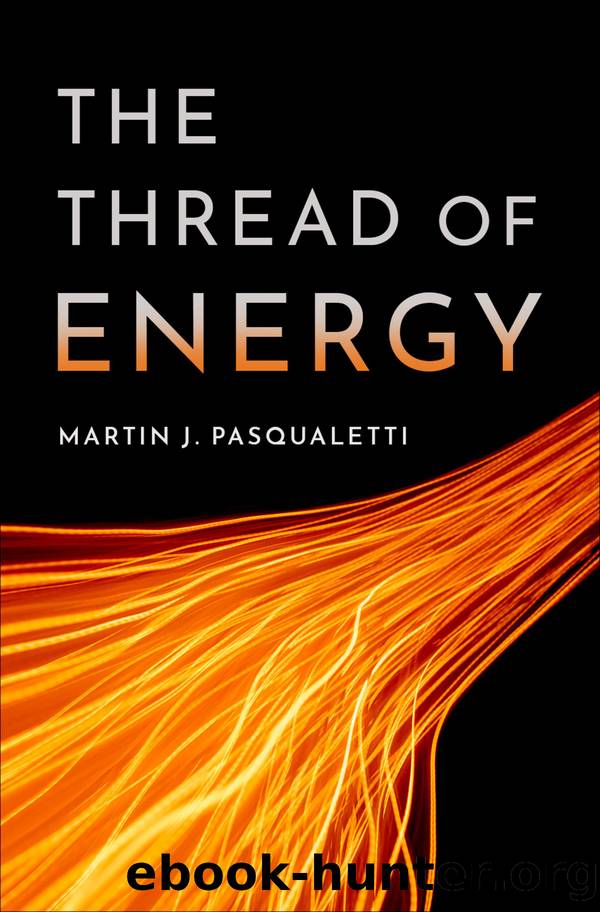The Thread of Energy by Pasqualetti Martin J.;

Author:Pasqualetti, Martin J.;
Language: eng
Format: epub
Publisher: Oxford University Press USA - OSO
Published: 2021-10-15T00:00:00+00:00
Figure 8.20 Iranâs nuclear facilities provide a constant worry to those countries that prefer that Iran not develop nuclear weapons capability.
Source: Base map courtesy of the Washington Institute. Corrected and re-drafted by Maryam Shakib.
Nonetheless, many countries grouped into a coalition to impose severe financial sanctions on Iran, which have weakened the countryâs economy and stoked domestic unrest. Once the economic and social costs of these sanctions accumulated to unacceptable levels, Iran decided to negotiate an agreement that would allow them to pursue a civilian nuclear program while agreeing to certain conditions that would diminish the chance of the proliferation of the civilian program into weapons. On July 14, 2015, the Joint Comprehensive Plan of Action (now called the Iran nuclear agreement) was formally agreed between Iran and the five permanent members of the United Nations Security CouncilâChina, France, Russia, United Kingdom, United Statesâplus Germany and the rest of the European Union.
Under the arrangement, Iran agreed to eliminate its stockpile of medium-enriched uranium, cut its stockpile of low-enriched uranium by 98 percent, and reduce by about two-thirds the number of centrifuges used in the enrichment process for at least fifteen years. Iran also agreed that for the next fifteen years it would only enrich uranium up to 3.67 percent, which is substantially below weapons-grade requirements. Iran also agreed not to build any new uranium-enriching or heavy-water facilities over the same period. Uranium-enrichment activities were to be limited to a single facility using first-generation centrifuges for ten years. Other facilities would be converted to avoid proliferation risks. To monitor and verify Iranâs compliance with the agreement, the International Atomic Energy Agency (IAEA) was to have regular access to all Iranian nuclear facilities. The agreement provided that in return for verifiably abiding by its commitments, Iran would receive relief from nuclear-related sanctions imposed by the United States, the European Union, and the United Nations Security Council, including the release of funds that had accumulated while the sanctions were in place.30
Whereas the negotiating countries believed that this was the best achievable agreement, neither every country nor every special interest viewed it with the same hope. For example, Israelâs prime minister, Benjamin Netanyahu, vehemently denounced the agreement in its entirety, contending that Israel would continue to suffer an existential threat from Iran. In support of the prime minister, President Donald Trump pulled the United States out of the agreement in 2018. Washington and Tehran have both said they would return to the original deal but they disagree on the steps to get there.
All this brings up a âwhat ifâ scenario: had Iran rejected the development of a civilian nuclear power program altogether, other countries would have been less worried that Iran could develop nuclear weapons. This offers an additional example of the continuing and dangerous mixing that occurs between geopolitics and energy that can lead to critical considerations of national security.31
Download
This site does not store any files on its server. We only index and link to content provided by other sites. Please contact the content providers to delete copyright contents if any and email us, we'll remove relevant links or contents immediately.
Zero to IPO: Over $1 Trillion of Actionable Advice from the World's Most Successful Entrepreneurs by Frederic Kerrest(4295)
Machine Learning at Scale with H2O by Gregory Keys | David Whiting(4182)
Never by Ken Follett(3791)
Harry Potter and the Goblet Of Fire by J.K. Rowling(3774)
Ogilvy on Advertising by David Ogilvy(3510)
Shadow of Night by Deborah Harkness(3303)
The Man Who Died Twice by Richard Osman(2997)
Book of Life by Deborah Harkness(2867)
The Tipping Point by Malcolm Gladwell(2827)
Will by Will Smith(2793)
0041152001443424520 .pdf by Unknown(2784)
My Brilliant Friend by Elena Ferrante(2774)
How Proust Can Change Your Life by Alain De Botton(2742)
Purple Hibiscus by Chimamanda Ngozi Adichie(2652)
How to Pay Zero Taxes, 2018 by Jeff A. Schnepper(2602)
Hooked: A Dark, Contemporary Romance (Never After Series) by Emily McIntire(2500)
Rationality by Steven Pinker(2291)
Borders by unknow(2229)
Can't Hurt Me: Master Your Mind and Defy the Odds - Clean Edition by David Goggins(2227)
